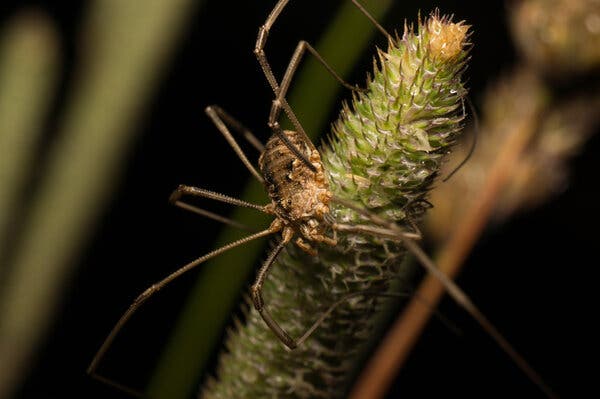Daddy Longlegs Have Been Hiding Extra Eyes From Us
The arachnids, which are not spiders, were thought to have only two eyes, compared with many more on spiders.

Some of the oldest known fossils of harvestmen, or daddy longlegs, seem to have two full pairs of eyes; modern organisms have only ever been known to have one.Credit…Roman Chukanov/Alamy
Guilherme Gainett, then a biologist at the University of Wisconsin-Madison, was looking through a microscope at the embryo of a daddy longlegs when he saw it — or, rather, saw them. Daddy longlegs, the group of splendidly leggy arachnids also known as harvestmen, have been thought to have just two eyes. But there on the animal’s body, illuminated with fluorescent markers, were what looked like four more vestigial eyes.
In a paper published last week in the journal Current Biology, Dr. Gainett, now at Boston Children’s Hospital, and his co-authors report that they believe they have discovered remnants in the harvestman species Phalangium opilio of what may have once been fully functional eyes in the arachnids’ ancestors. Though these vestigial eyes don’t mature fully, they appear on the harvestmen’s bodies as they develop, shaped by many of the same genes as the creatures’ true eyes.
Arachnids include spiders, scorpions, harvestmen and other arthropods, and divining the relationships among this sprawling group of organisms is tricky. To do so, researchers must draw on both genetic information from modern arachnids and fossils of those that have long since vanished. Interpretations of the relationships among arachnids can vary widely: Dr. Gainett and his graduate school adviser; Prashant Sharma, a biologist at the University of Wisconsin; and their colleagues courted taxonomic controversy in 2022 when they published a family tree that put horseshoe crabs, previously thought not to be arachnids, in the group.
For the current study, Dr. Gainett used fluorescent tags to study the development of harvestman eyes. The tags were designed to stick to opsins, light-sensitive proteins that exist in eyes across the animal kingdom. Looking at the shapes traced by the tags, he matched the locations of the unexpected opsins on the harvestmen to approximately where extra eyes grow on spiders and horseshoe crabs. (Spiders typically have eight eyes, and horseshoe crabs have 10.) These findings suggest that the neural architecture that handles the daddy longlegs’ vision may be quite old. The results could also help in sketching out the family tree of arachnids.
The researchers believe that this new finding helps explain some mysteries about daddy longlegs. Some of the oldest known fossils of harvestmen, in deposits of quartz, seem to have two full pairs of eyes; modern organisms have only ever been known to have one. The discovery of these vestigial eyes may help link the fossils, which are thought to be more than 400 million years old, more directly with their descendants, clarifying their place on the arachnid family tree.
The study, Dr. Sharma said, “suggests they have changed very little for a very long time.”
The researchers also found that a variety of genes connected to vision were involved in shaping these vestigial eyes, two of which are just above the joints of the harvestman’s legs.
“Can they see with their shoulders?” Dr. Gainett asked. Probably not in the way most people would imagine — there are no lenses associated with these regions to focus light. But perhaps these patches of tissue are still sensitive to light, the researchers say. They might be able to help detect the difference between darkness and light, although behavioral studies would be needed to investigate that possibility.
The findings highlight the serendipity that sometimes results from scientific discoveries: Dr. Gainett and Dr. Sharma had been hoping to understand the process by which arachnids that don’t need multiple pairs of eyes might give them up over evolutionary time.
“We started out by saying, Let’s see how these animals lost their eyes,” Dr. Sharma said. “And they haven’t — they actually have more than we thought.”